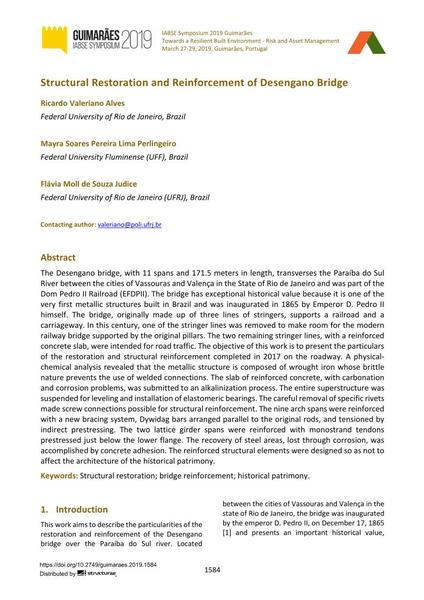Structural Restoration and Reinforcement of Desengano Bridge

|
|
|||||||||||
Bibliographic Details
| Author(s): |
Ricardo Valeriano Alves
(Federal University of Rio de Janeiro, Brazil)
Mayra Soares Pereira Lima Perlingeiro (Federal University Fluminense (UFF), Brazil) Flávia Moll de Souza Judice (Federal University of Rio de Janeiro (UFRJ), Brazil) |
||||
|---|---|---|---|---|---|
| Medium: | conference paper | ||||
| Language(s): | English | ||||
| Conference: | IABSE Symposium: Towards a Resilient Built Environment Risk and Asset Management, Guimarães, Portugal, 27-29 March 2019 | ||||
| Published in: | IABSE Symposium Guimarães 2019 | ||||
|
|||||
| Page(s): | 1584-1591 | ||||
| Total no. of pages: | 8 | ||||
| DOI: | 10.2749/guimaraes.2019.1584 | ||||
| Abstract: |
The Desengano bridge, with 11 spans and 171.5 meters in length, transverses the Paraíba do Sul River between the cities of Vassouras and Valença in the State of Rio de Janeiro and was part of the Dom Pedro II Railroad (EFDPII). The bridge has exceptional historical value because it is one of the very first metallic structures built in Brazil and was inaugurated in 1865 by Emperor D. Pedro II himself. The bridge, originally made up of three lines of stringers, supports a railroad and a carriageway. In this century, one of the stringer lines was removed to make room for the modern railway bridge supported by the original pillars. The two remaining stringer lines, with a reinforced concrete slab, were intended for road traffic. The objective of this work is to present the particulars of the restoration and structural reinforcement completed in 2017 on the roadway. A physical- chemical analysis revealed that the metallic structure is composed of wrought iron whose brittle nature prevents the use of welded connections. The slab of reinforced concrete, with carbonation and corrosion problems, was submitted to an alkalinization process. The entire superstructure was suspended for leveling and installation of elastomeric bearings. The careful removal of specific rivets made screw connections possible for structural reinforcement. The nine arch spans were reinforced with a new bracing system, Dywidag bars arranged parallel to the original rods, and tensioned by indirect prestressing. The two lattice girder spans were reinforced with monostrand tendons prestressed just below the lower flange. The recovery of steel areas, lost through corrosion, was accomplished by concrete adhesion. The reinforced structural elements were designed so as not to affect the architecture of the historical patrimony. |
||||
| Keywords: |
structural restoration bridge reinforcement historical patrimony
|
||||
